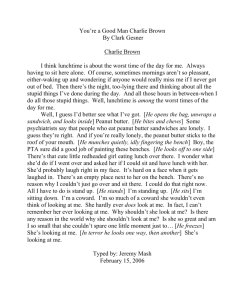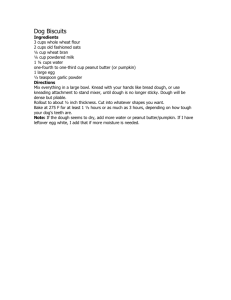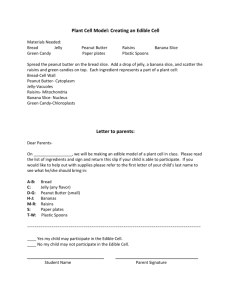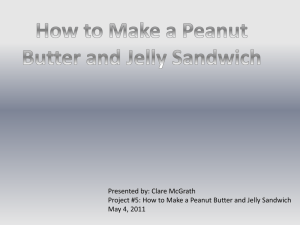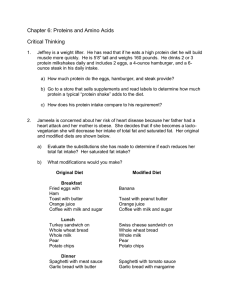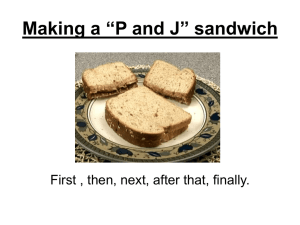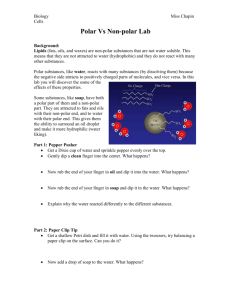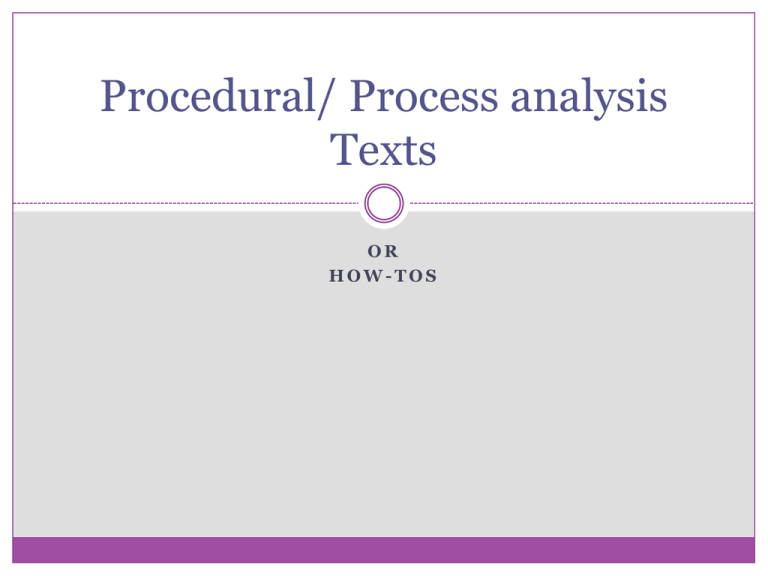
Procedural/ Process analysis
Texts
OR
HOW-TOS
What is the purpose of a Procedural text/ Process
Analysis?
To give step by step instructions
To tell how something is done
Definition:
paragraph or essay in which a writer explains step by
step how something is done or how to do something.
can take one of two forms:
(1) it can provide information about how something works
(informative)
(2) it can explain how to do something (directive).
Directive
instructing the readers to follow certain steps.
This often involves addressing the reader directly with the
imperative verb tense.
In other words, you give commands directly to your reader in
a directive type of process analysis.
Example: "How to mess up on a first date: Show up
late. Don't apologize. Check out other members of the
opposite sex while pretending to listen." etc etc
Informative
provides readers with a thorough understanding of a
process that they would like to know something (or
know more) about.
the emphasis shifts from how-to-do-it instructions to
how-it-is-done explanations.
Readers should come away from informative-process
writing with a general understanding of the principles
involved in how something works or happens—
whether it is a simple household appliance or a
complex political crisis.
informative
mechanical (how an instant camera works)
scientific (how our lungs function)
historical (how the United States came to suffer in
Vietnam)
natural (how rain clouds form)
social (how women’s roles in society have changed)
creative (how songs are written)
or psychological (how dreams are interpreted
What are the characteristics of a good
Procedural/Process Analysis text?
Progresses sequentially
In logical step by step order
Contains factual content presented in an objective manner
Uses words that relate to time: first, next, etc
1. First do this
2. next do this
3. then do this
TIPS to Writing a Good Procedural/ Process
Analysis
1. Understand the process:
In order to illuminate your ideas about a process, you must
first understand how it happens or happened, and in what
order the steps come.
TIPS (continued)
2. Consider your thesis:
What is it you want your readers to know when they are done
reading your essay?
If your process analysis is a recipe, then the outcome is obvious you want your readers to have prepared a successful dish.
An academic process analysis should be just as focused, but with
the added bonus of having some insight about the topic revealed in
the process.
TIPS (continued)
3. List all steps:
Make sure you haven't left anything out.
particularly important for a directive process analysis
should be thorough and detailed from beginning to end.
Be sure to include transitions, or markers that delineate one step
of the process from the next.
TIPS (continueD)
4. Define any unfamiliar terms:
This seems self-evident, but many people don't think about it
What are some examples of Procedural/Process
Analyses texts?
Recipes
Rule books
Directions (like from
MapQuest)
Instruction books
How to books/posters
Experiments
Cheeseburger Soup I
Prep Time: 20 Minutes
Cook Time: 30 Minutes
Ready In: 50 Minutes
Servings: 8
INGREDIENTS:
1/2 pound ground beef
3/4 cup chopped onion
3/4 cup shredded carrots
3/4 cup chopped celery
1 teaspoon dried basil
1 teaspoon dried parsley
4 tablespoons butter
3 cups chicken broth
4 cups cubed potatoes
1/4 cup all-purpose flour
2 cups cubed Cheddar cheese
1 1/2 cups milk
1/4 cup sour cream
DIRECTIONS:
In a large pot, melt 1 tablespoon butter or margarine over medium heat: cook and stir vegetables and beef , until beef is
brown.
Stir in basil and parsley. Add broth and potatoes. Bring to a boil, then simmer until potatoes are tender, about 10-12
minutes.
Melt the remainder of butter and stir in flour. Add the milk, stirring until smooth.
Gradually add milk mixture to the soup, stirring constantly. Bring to a boil and reduce heat to simmer. Stir in cheese. When
cheese is
melted, add sour cream and heat through. Do not boil.
ALL RIGHTS RESERVED © 2013 Allrecipes.com Printed from Allrecipes.com 10/16/2013
Put this in order:
Dividing Fractions
Multiply the first fraction by that reciprocal
Simplify the fraction (if needed)
Turn the second fraction (the one you want to divide
by) upside-down (this is now a reciprocal)
What’s missing:
Assumptions: that the reader knows what "bread," "peanut butter," "jelly," and "knife" represent.
Ingredients
Two slices of bread (if not pre-sliced, approximately square length and height, approximately one inch in width or thickness)
One dull knife
One jar of peanut butter
One jar of jelly
One clean surface (plate, cutting board, etc.)
1. Take one slice of the bread and place in on the flat surface.
2. Take the knife, and scrape some peanut butter from the jar onto the sharper end.
3. Spread the peanut butter onto the largest plane/face (the side with the largest surface area) of the bread.
4. If the peanut butter does not cover the surface, repeat steps 2 and 3 until the surface is covered.
5. Take the second slice of bread and place it on the flat surface.
6. Repeat steps 2-4 on the second piece of bread replacing "peanut butter" with "jelly."
7. Place the jellied side of the second piece of bread onto the peanut buttered side of the first piece of bread,
lining up the edges.
8. And, the final, and most important step, take the sharp end of the knife and press it from the upper left
corner of the now-joined pieces of bread to the lower right corner in a diagonal line, thus cutting the sandwich
into two wedges.
Is this a procedural/process analysis

